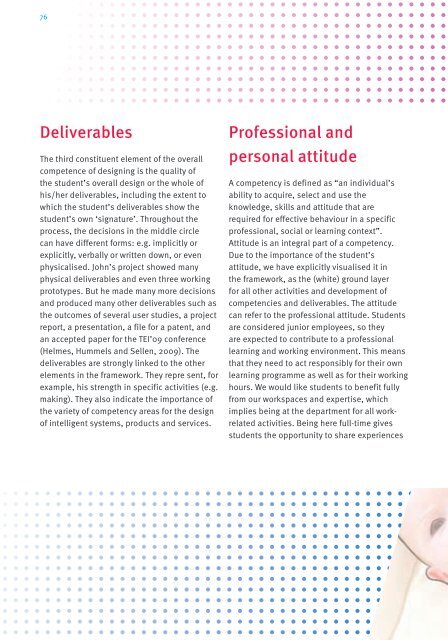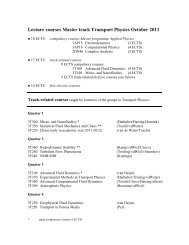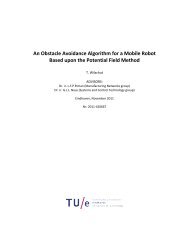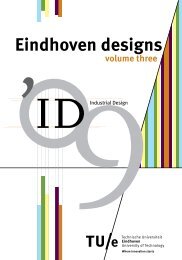Education guide 'Eindhoven designs' - Technische Universiteit ...
Education guide 'Eindhoven designs' - Technische Universiteit ...
Education guide 'Eindhoven designs' - Technische Universiteit ...
You also want an ePaper? Increase the reach of your titles
YUMPU automatically turns print PDFs into web optimized ePapers that Google loves.
76<br />
Deliverables<br />
The third constituent element of the overall<br />
competence of designing is the quality of<br />
the student’s overall design or the whole of<br />
his/her deliverables, including the extent to<br />
which the student’s deliverables show the<br />
student’s own ‘signature’. Throughout the<br />
process, the decisions in the middle circle<br />
can have different forms: e.g. implicitly or<br />
explicitly, verbally or written down, or even<br />
physicalised. John’s project showed many<br />
physical deliverables and even three working<br />
prototypes. But he made many more decisions<br />
and produced many other deliverables such as<br />
the outcomes of several user studies, a project<br />
report, a presentation, a file for a patent, and<br />
an accepted paper for the TEI’09 conference<br />
(Helmes, Hummels and Sellen, 2009). The<br />
deliverables are strongly linked to the other<br />
elements in the framework. They repre sent, for<br />
example, his strength in specific activities (e.g.<br />
making). They also indicate the importance of<br />
the variety of competency areas for the design<br />
of intelligent systems, products and services.<br />
Professional and<br />
personal attitude<br />
A competency is defined as “an individual’s<br />
ability to acquire, select and use the<br />
knowledge, skills and attitude that are<br />
required for effective behaviour in a specific<br />
professional, social or learning context”.<br />
Attitude is an integral part of a competency.<br />
Due to the importance of the student’s<br />
attitude, we have explicitly visualised it in<br />
the framework, as the (white) ground layer<br />
for all other activities and development of<br />
competencies and deliverables. The attitude<br />
can refer to the professional attitude. Students<br />
are considered junior employees, so they<br />
are expected to contribute to a professional<br />
learning and working environment. This means<br />
that they need to act responsibly for their own<br />
learning programme as well as for their working<br />
hours. We would like students to benefit fully<br />
from our workspaces and expertise, which<br />
implies being at the department for all workrelated<br />
activities. Being here full-time gives<br />
students the opportunity to share experiences

















